The Dictatorship
Is the White House for sale? New reports on Trump’s crypto ventures raise concern.

By Stephanie Ruhle and Elliot Metz
This is an adapted excerpt from the May 5 episode of “The 11th Hour with Stephanie Ruhle.”
Investors appear to be getting a little impatient for some good news on Donald Trump’s trade war. On Tuesday, the S&P 500 continued to sink after snapping its nine-day winning streak on Monday. The Dow Jones Industrial Average and the Nasdaq Composite also finished the day down.
But this news also serves as a reminder to make sure we look at not just what this administration says, but how it operates.
Those losses could be linked to Trump opening a new front in his trade war. Seemingly out of nowhere, on Sunday Trump announced on social media that he wants to put tariffs on movies not made in the United States.
“The Movie Industry in America is DYING a very fast death,” Trump wrote on Truth Social. “Other Countries are offering all sorts of incentives to draw our filmmakers and studios away from the United States. Hollywood, and many other areas within the U.S.A., are being devastated. … Therefore, I am authorizing the Department of Commerce, and the United States Trade Representative, to immediately begin the process of instituting a 100% Tariff on any and all Movies coming into our Country that are produced in Foreign Lands. WE WANT MOVIES MADE IN AMERICA, AGAIN!”
Still no word from the White House on how placing tariffs on foreign-made movies would even work. However, we have learned that actor and Trump ally Jon Voight is directly involved in the president’s push to “make Hollywood great again.”
A 100% tariff on imported movies would do pretty much nothing to “bring movies back” to America. What it does do is welcome retaliation, and if other countries impose the same tariff on the U.S. film industry, Hollywood will lose a lot of money and a lot of jobs.
But this news also serves as a reminder to look at not just what this administration says, but how it operates.
This deal would be a massive windfall for World Liberty Financial, which, as The New York Times has reported, is largely owned by a Trump family corporate entity.
Trump’s proposal to slap tariffs on foreign films has dominated headlines, joined by outrage over an AI image of Trump as pope and his grand ideas for rebuilding Alcatraz. But it’s important to also look at the stories Trump has not been talking about.
Last week, a United Arab Emirates state-backed investment firm put $2 billion in one of Trump’s cryptocurrencies. The deal was announced onstage at a cryptocurrency convention in Dubai by Zach Witkoff, a co-founder of the Trump family crypto venture, World Liberty Financial, and son of the president’s envoy to the Middle East, Steve Witkoff. Also on stage at the time of that announcement: Eric Trump.
This deal would be a massive windfall for World Liberty Financial, which, as The New York Times has reported, is largely owned by a Trump family corporate entity.
On the same day as that announcement, Bloomberg News, citing people familiar with the matter, reported the U.S. is considering relaxing restrictions on Nvidia’s chip sales to the United Arab Emirates. This would be a huge win for the UAE, as its progress on artificial intelligence has been limited due to the Biden administration’s rules on chips. All of this comes as Trump is set to visit the country as part of his Middle East trip next week.
But that’s not all. There’s another story involving Trump’s crypto ventures that might have missed your radar. An international trucking logistics firm just announced it plans to buy $20 million of Trump’s crypto coins. Now maybe they’re not trying to buy influence on trade policy, but why exactly would a trucking company roll the dice on a meme coin that just happens to benefit the president?
It’s reports like these that have us asking: Is this White House for sale?

Stephanie Ruhle is host of “The 11th Hour” at 11 p.m. ET on BLN and senior business analyst for NBC News.
Elliot Metz
Elliot Metz is a producer on “The 11th Hour with Stephanie Ruhle.”
Allison Detzel
contributed
.
The Dictatorship
Canadian Prime Minister Carney will meet with President Trump, hoping to ease trade war tensions
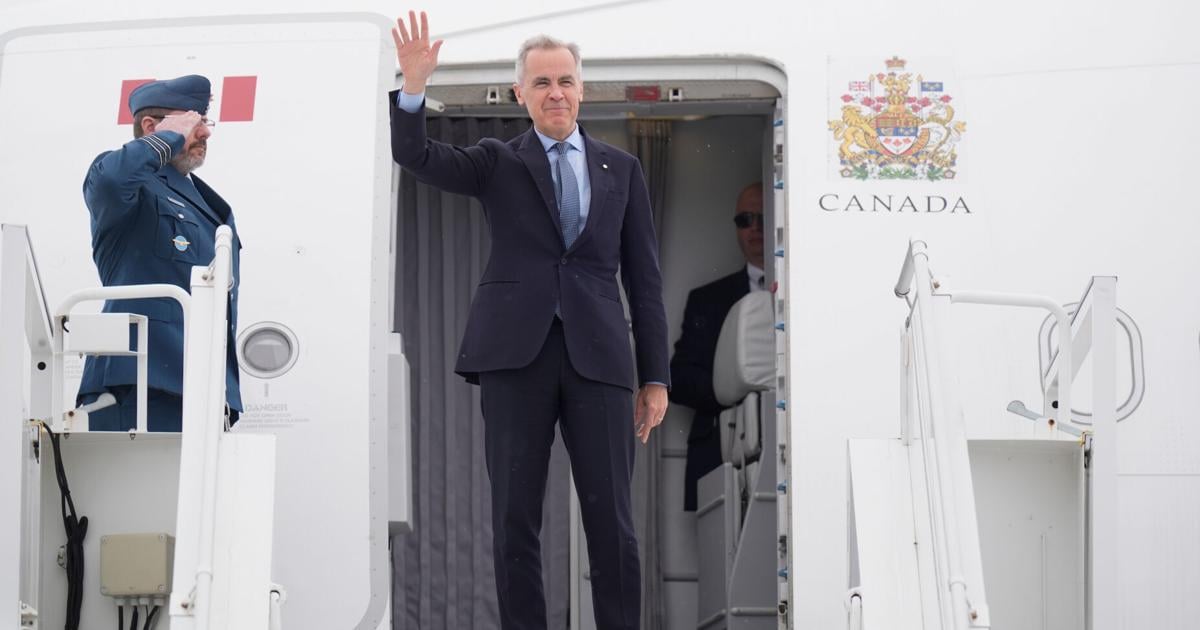
WASHINGTON (AP) — U.S. President Donald Trump and Canadian Prime Minister Mark Carney faced off in the Oval Office on Tuesday and showed no signs of retreating from their gaping differences in an ongoing trade war that has shattered decades of trust between the two countries.
The two kept it civil, but as for Trump’s calls to make Canada the 51st state, Carney insisted his nation was “not for sale” and Trump shot back, “time will tell.”
Asked by a reporter if there was anything Carney could tell him to lift his tariffs of as much as 25% on Canada, Trump bluntly said: “No.”
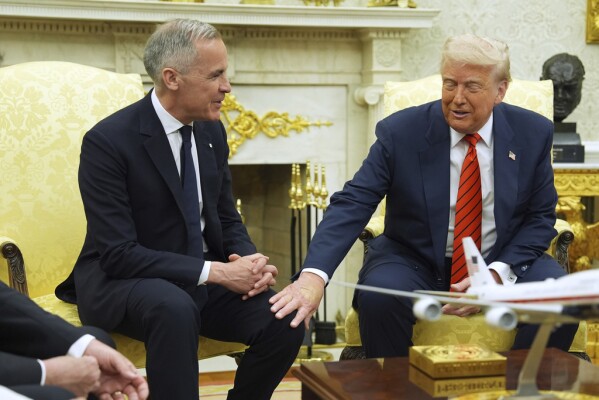
President Donald Trump meets Canadian Prime Minister Mark Carney in the Oval Office of the White House, Tuesday, May 6, 2025, in Washington. (AP Photo/Evan Vucci)
President Donald Trump meets Canadian Prime Minister Mark Carney in the Oval Office of the White House, Tuesday, May 6, 2025, in Washington. (AP Photo/Evan Vucci)
The U.S. president added for emphasis, “Just the way it is.”
Carney acknowledged that no bit of rhetoric on tariffs would be enough to sway Trump, saying that “this is a bigger discussion.”
“There are much bigger forces involved,” the Canadian leader continued. “And this will take some time and some discussions. And that’s why we’re here, to have those discussions.”
The meeting between the two leaders showcased the full spectrum of Trump’s unique mix of aggression, hospitality and stubbornness.
Shortly before Carney’s arrival, Trump insulted Canada by posting on social media that the United States didn’t need “ANYTHING” from its northern neighbor, only to then turn on the charm and praise Carney’s election win in person before showing his obstinance on matters of policy substance.
Carney won the job of prime minister by promising to confront the increased aggression shown by Trump, even as he has preserved the calm demeanor of an economist who has led the central banks of both Canada and the United Kingdom.
At times, Carney struggled to interject his views and raised his hand to talk as Trump held forth at length and veered between topics, touching on California Democratic Gov. Gavin NewsomCarney’s predecessor, Justin Trudeauand teasing a “great” upcoming announcement that’s “not necessarily on trade.”
Trump offended Canada’s sense of pride and friendship by saying he wants to make Canada the 51st U.S. state and levying steep tariffs against an essential partner in the manufacturing of autos and the supply of oil, electricity and other goods. The outrage provoked by Trump enabled Carney’s Liberal Party to score a stunning comeback victory last month as the trade war and attacks on Canadian sovereignty have outraged voters.
Trump said the two would not discuss making Canada part of the U.S., even as he insisted the idea would lead to lower taxes for Canadians.
“It’s not for sale,” Carney said. “It won’t be for sale. Ever. But the opportunity is in the partnership and what we can build together.”
Trump persisted by saying that the United States did not want to buy autos from Canada, even if the vehicles were also assembled in America. The U.S. leader insisted that the $63 billion trade deficit in goods — which he inflated to $200 billion — was a subsidy that needed to come an end.
The meeting never devolved into the outburst that the public saw in Trump’s meeting with Ukrainian President Volodymyr Zelenskyy, who was berated by the U.S. president and his team for not being sufficiently deferential. Nor did it have the ease of Trump’s sit down with the United Kingdom’s Prime Minister Keir Starmerwho invited Trump for a visit provided by King Charles III.
Carney later described his conversation with Trump as “wide ranging” and “constructive,” telling reporters that the prospect is there for positive negotiations but there would be “zigs and zags.” Carney said he stressed the value that Canadian companies and factories created for U.S. automakers while stressing that it was unfair to assume one meeting could resolve any differences.
“I wouldn’t have expected white smoke coming out of this meeting,” Carney said after the Tuesday meeting, referencing the signal that a new pope has been selected.
Carney said that he privately asked Trump to stop calling Canada the 51st state during their meeting. But when pressed on how Trump responded, the Canadian prime minister said: “He’s the president. He’s his own person.”
Trump was later asked if he would give Carney the same “governor” nickname that he had put on Trudeau. The nickname was a slight meant to imply that Canada’s leader would eventually be just one of many U.S. governors.
“As far as calling him Gov. Carney, no, I haven’t done that yet, and maybe I won’t,” Trump said. “I did have a lot of fun with Trudeau. But I think this is, this is a big step. It’s a good step up for Canada.”
Trump added that the meeting with Carney had been “great” and that he thought the ongoing relationship would be “strong.”
A senior Canadian government official said the president asked Carney his perspective on a variety of foreign policy issues including Iran, Russia, Ukraine and China. The official, who spoke on condition of anonymity as they were not authorized to speak publicly about the matter, said Trump was looking forward to the G-7 meeting in Alberta, Canada.
The stakes of the meeting were high and the messages beforehand mixed. Trump told reporters on Monday that he wasn’t quite sure why Carney was visiting.
“I’m not sure what he wants to see me about,” Trump said. “But I guess he wants to make a deal.”
U.S. Commerce Secretary Howard Lutnick further stoked doubts about their interest in repairing the relationship with Canada in a Monday interview on Fox Business Network’s “Kudlow” show.
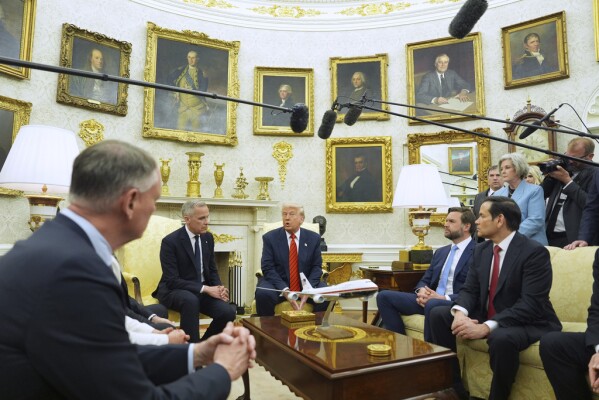
President Donald Trump meets Canadian Prime Minister Mark Carney in the Oval Office of the White House, Tuesday, May 6, 2025, in Washington. (AP Photo/Evan Vucci)
President Donald Trump meets Canadian Prime Minister Mark Carney in the Oval Office of the White House, Tuesday, May 6, 2025, in Washington. (AP Photo/Evan Vucci)
Asked if the U.S. could make a deal with Canada, Lutnick called the country a “socialist regime” that has been “basically feeding off America.” Lutnick said Tuesday’s meeting would be “fascinating.”
Carney, at a Friday news conference ahead of his trip, said the talks would focus on immediate trade pressures and the broader economic and national security relationships. He said his “government would fight to get the best deal for Canada” and “take all the time necessary” to do so, even as Canada pursues a parallel set of talks to deepen relations with other allies and lessen its commitments with the U.S.
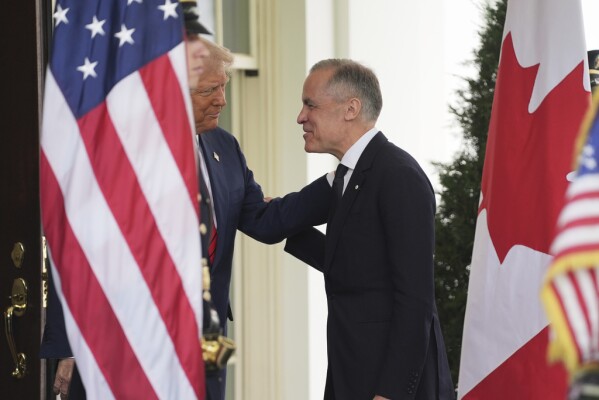
President Donald Trump greets Canadian Prime Minister Mark Carney at the White House, Tuesday, May 6, 2025, in Washington. (AP Photo/Evan Vucci)
President Donald Trump greets Canadian Prime Minister Mark Carney at the White House, Tuesday, May 6, 2025, in Washington. (AP Photo/Evan Vucci)
Trump has maintained that the U.S. doesn’t need anything from Canada. He is actively going after a Canadian auto sector built largely by U.S. companies, saying, “They’re stopping work in Mexico, and they’re stopping work in Canada, and they’re all moving here.” He also said the U.S. doesn’t need Canada’s energy — though nearly one-fourth of the oil that the U.S. consumes daily comes from the province of Alberta.
The president has also disparaged Canada’s military commitments despite a partnership that ranges from the beaches of Normandy in World War II to remote stretches of Afghanistan. He said on Tuesday with Carney that the U.S. would conti nue to provide national security support to Canada.
Trump has imposed 25% tariffs on steel and aluminum and tariffs on other products outside the United States-Mexico-Canada Agreement, in some cases ostensibly to address relatively low volumes of fentanyl intercepted at the northern border. That has jeopardized a closely entwined trade relationship as Canada sees an increasing need to build relations with the European Union and other nations.
Canada is the top export destination for 36 U.S. states. Nearly $3.6 billion Canadian (US$2.7 billion) worth of goods and services cross the border each day. About 60% of U.S. crude oil imports are from Canada, and 85% of U.S. electricity imports are from Canada.
Canada is also the largest foreign supplier of steel, aluminum and uranium to the U.S. and has 34 critical minerals and metals that the Pentagon is eager for and investing in for national security. Canada is one of the most trade-dependent countries in the world, and 77% of Canada’s exports go to the U.S.
The Dictatorship
Trump just took a sledgehammer to our pandemic preparedness

President Donald Trump’s executive order issued Monday would end federal funding for gain-of-function (GoF) research. The EO, like so many others attacking science, contains false and misleading arguments. It is mere political theater, rather than a serious plan to strengthen our preparedness for the next pandemic.
The EO ends federal funding for GoF conducted by foreign entities in “countries of concern,” without specifying the countries other than China. Notably, the EO defines “dangerous gain-of-function research” broadly, not limiting application of the order to pathogens with pandemic potential. It separately suspends funding for vaguely defined “other life-science research” determined to pose a threat to U.S. health, safety, or security. That means the administration could stop funding important research even if it doesn’t involve a gain of function. The order also instructs the Office of Science and Technology Policy to establish guidance suspending all federally funded GoF research within the U.S. and to oversee such research carried out without federal funds. The EO purports to target our adversaries like China, but it paints with a broad brush.
It is mere political theater, rather than a serious plan to strengthen our preparedness for the next pandemic.
So, what is GoF research, and what are its benefits and dangers? Truth be told, GoF is poorly definedbut broadly encompasses research that enhances an organism’s (like a pathogen’s) function. A subset of this research could make a pathogen more transmissible or pathogenic. Scientists employ GoF virology techniques to better understand the biology, ecology and pathogenesis of viruses. GoF experiments help scientists understand how quickly resistance or viral mutations develop. These experiments can be important for developing lifesaving vaccines and treatments, for example, helping researchers understand the evolution of coronaviruses.
It is important to stress that GoF research involving pathogens with pandemic potential raises vital biosafety and biosecurity concerns. We should worry that enhanced pathogens may leak from an unsecured lab or be used in a bioterrorism attack.
These concerns have led the National Institutes of Health to tighten biosafety controls and stringently regulate how, when and where GoF research can be conducted. NIH already employs multiple layers of review and oversight of GoF research. In 2014, the Obama administration paused funding for high-risk GoF studies involving SARS, MERS and novel influenza viruses. It was the first Trump administration that lifted the pause in 2017, initiating a rigorous evaluation process for research proposals using a Department of Health and Human Services-led risk-benefit analysis. The Biden administration further reinforced GoF safeguards, requiring researchers to submit a detailed risk-mitigation plan, a policy that came into force just this month.
Trump has taken aim at GoF research because he believes a laboratory leak at the Wuhan Institute of Virology caused the Covid-19 pandemic. He attacks the NIH, and especially Dr. Anthony Fauci, for making a grant to the EcoHealth Alliance. On Jan. 17, HHS cut off all funding and formally debarred EcoHealth and its former president, Peter Daszak, for five years after a scathing partisan report from the GOP-led House Select Subcommittee on the Coronavirus Pandemic.
We may never know the true origins of Covid, and the lab leak theory remains a possibility.
Yet, most evidence still supports a natural zoonotic spilloverincluding SARS-CoV-2-positive environmental samples collected from Wuhan’s Huanan Seafood Wholesale Market, epidemiologic linking to the market, and genetic analysis of two distinct viral lineages in early Covid-19 cases. On the other hand, there is no known progenitor strain to SARS-CoV-2 associated with the Wuhan laboratory.
Of course it’s important for the future of public health to understand as best we can what led to the pandemic. But that’s not what’s motivating Trump and his administration — rather, they seek to reopen old political battles and boost conspiracy theories.
Of course it’s important for the future of public health to understand as best we can what led to the pandemic. But that’s not what’s motivating the Trump administration.
Trump’s latest executive order is part of a series of steps that weaken federal health agencies, including a 40% funding cut to NIH and a 50% cut to the Centers for Disease Control and Prevention. NIH has proposed slashing indirect funding for all U.S. universities, a devastating blow to research. NIH announced it would end billions in funding for international research, imperiling global health research on infectious diseases. And we have not even mentioned the fact that Health Secretary Robert F. Kennedy Jr. has undermined scientific advisory committees at NIH and CDC, put a vaccine skeptic in charge of a major study looking into vaccines and autism, and fomented distrust in vaccines.
What the president should do is focus on current and future steps to prepare us for the next pandemic: tighter biosecurity and biosafety protections in laboratories domestically and abroad, continued strong regulatory oversight of GoF research, investments in science and public health, full funding for NIH and CDC, and rejoining the World Health Organization.
The Trump administration seems determined to weaken U.S. preparedness for the next pandemic by eviscerating NIH and its ability to conduct and fund research into deadly pathogens together with its global partners. If we truly want to harden our defenses against pandemics, we need to stop relitigating the lab leak hypothesis, and jump-start research and innovation at the NIH and beyond.
GoF research will continue globally because it is important, and there is a lot we don’t know about how viruses evolve. But Trump has made it so that biomedical research will have lost a major collaborator in the U.S. Our scientists will now have fewer tools to detect, understand and fight viral disease.
CORRECTION (May 6, 2025, 7:39 p.m. ET): A previous version of this article incorrectly listed Iran as one of the “countries of concern” named in the executive order.
Lawrence Gostin
Lawrence Gostin is a Distinguished Professor at Georgetown University where he directs the WHO Center on Global Health Law.
Alexandra Finch
Alexandra Finch is Senior Associate at the O’Neill Institute for National and Global Health Law, Georgetown University.
The Dictatorship
Linda McMahon’s unhinged letter to Harvard is a sign of the Trump administration’s weakness
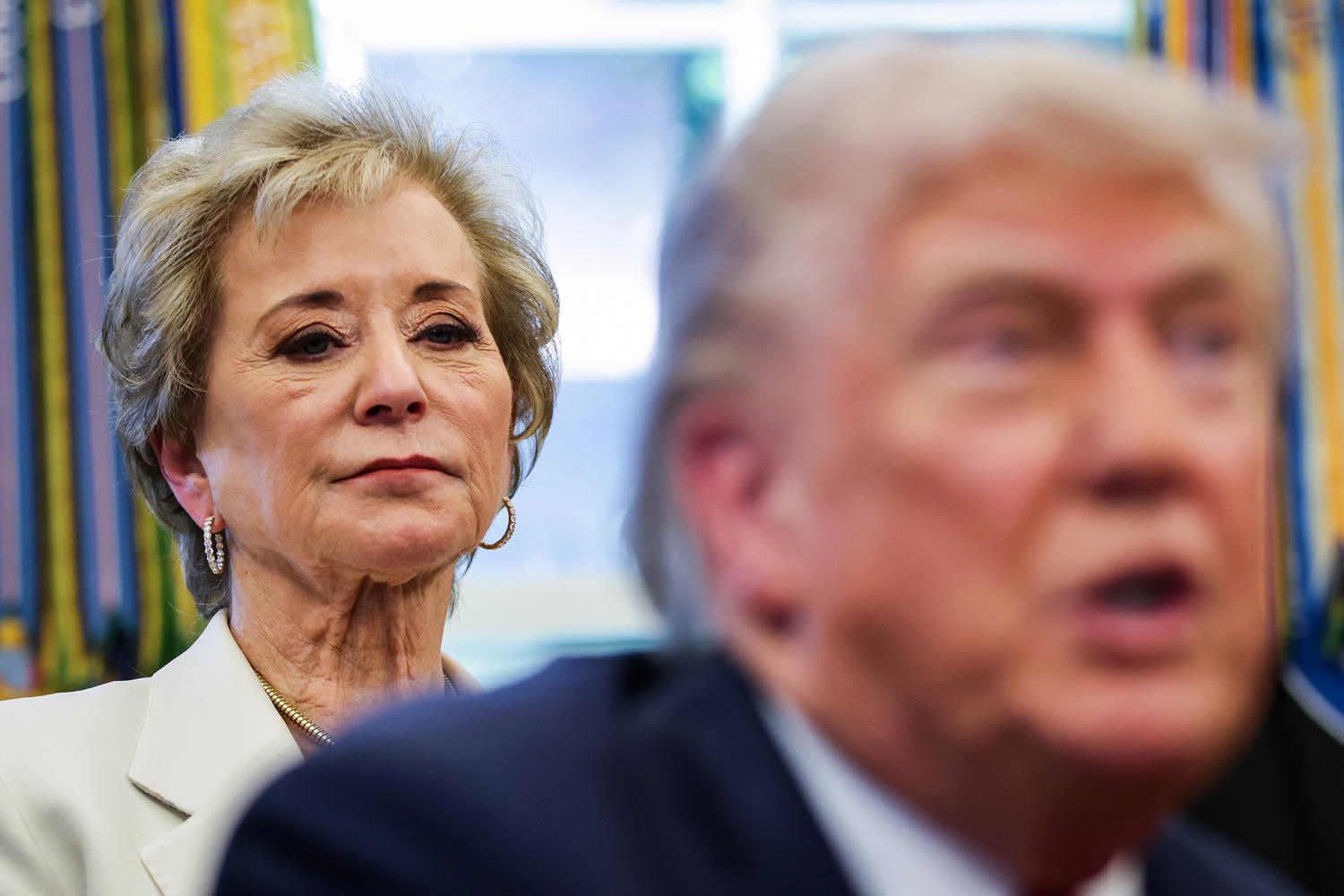
On Monday, Secretary of Education Linda McMahon sent Harvard University an unhinged letter, which she also posted to X, decreeing that the higher education institution could no longer apply for government grantspresumably to do things like find cures for cancer and other diseases.
Instead of scaling back its attacks on Harvard in light of the Perkins Coie decision, however, the administration has doubled down.
Opening the letter with the statement that the federal government “has a sacred responsibility to be a wise and important steward of American taxpayer dollars,” McMahon claims the university is being run poorly and engages in race-based preferences in admissions and hiring. She also asserts that the university has rejected “common-sense reforms” urged by the administration, including committing to “a return to merit-based admission and hiring.”
The ultimate punishment for these transgressions is the following: “Given these and other concerning allegations, this letter is to inform you that Harvard should no longer seek GRANTS from the federal government, since none will be provided.”
McMahon’s letter came just days after a federal judge in Washington, D.C. issued a stinging rebuke to the Trump administration in the first significant decision in a case involving the free-speech rights of a private law firm.
Judge Beryl Howell found the administration’s retributive actions against the Perkins Coie law firm violated the First Amendment, which should have sent a signal to the administration that efforts to punish private institutions for practices and policies the administration does not favor cannot withstand constitutional challenge. But that hasn’t stopped the administration from renewing its attacks on Harvard University.
Before the decision, President Donald Trump claimed his administration would rescind the tax-exempt status of Harvard, a move that would clearly be illegal. Instead of scaling back its attacks on Harvard in light of the Perkins Coie decision, however, the administration has doubled down.
But the attack on Harvard is on even shakier legal and constitutional ground than the administration’s attacks on law firms. American universities enjoy strong First Amendment rights that protect what they teach, who they hire and how they operate. The McMahon letter — which purports to operate as notice to the university that Harvard need not apply for federal research grants — is meant to deter the university from seeking federal funding. I doubt that it will.
At the same time, it sends a clear message to federal agencies, like the National Science Foundation and the National Institutes of Health, that they should reject any application coming from Harvard. And it does so under the banner of purporting to further merit-based admissions and hiring practices. But even the administration’s supposed cure involves what? Decision-making that is not based on merit.
Indeed, according to McMahon’s letter, Harvard should not bother applying for federal grants because none will be forthcoming. Such decisions would not be based on the merit of those applications or the research teams behind them, but on the administration’s grudge against the university.
Harvard should continue to resist such efforts and can fully expect to have not just its day in court, but a victorious one at that.
So, lodging a litany of claims that Harvard is making decisions not on merit but based on diversity, equity and inclusion, will ultimately lead to funding decisions by the federal government that are not based on merit. As a result, should such policies go into effect, we won’t have the most qualified researchers addressing some of the world’s thorniest public health problems, only those who are approved by the administration’s political leadership.
The university is already suing the administration over prior cuts in grants that violate the First Amendment rights of the university and over failing to follow the administrative procedures for cutting such funds required under the law. Add this most recent attack to the basis for the lawsuit. Harvard should also challenge the mere threat from President Trump that the university should lose its tax-exempt status, which, standing alone, violates federal law as well.
Harvard should continue to resist such efforts and can fully expect to have not just its day in court, but a victorious one at that. In the meantime, what will be lost should federal agencies actually follow McMahon’s directive? What public health projects will go unfunded? What new research on life-saving cures will end because of the administration’s most recent fit?
Harvard should challenge, and courts should review, this most recent attack on Harvard to not just stem a further erosion of First Amendment freedoms, but to preserve the national interest in having the best researchers working on our most important public health challenges.
Ray Brescia
Ray Brescia is a professor of law at Albany Law School and author of the book, “The Private Is Political: Identity and Democracy in the Age of Surveillance Capitalism.”
-
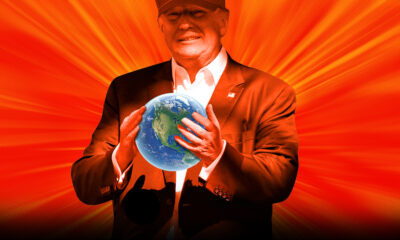
 The Josh Fourrier Show6 months ago
The Josh Fourrier Show6 months agoDOOMSDAY: Trump won, now what?
-
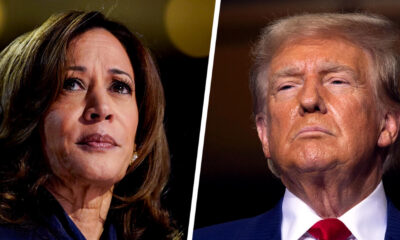
 Politics6 months ago
Politics6 months agoWhat 7 political experts will be watching at Tuesday’s debate
-
Uncategorized6 months ago
Bob Good to step down as Freedom Caucus chair this week
-
Economy6 months ago
Fed moves to protect weakening job market with bold rate cut
-
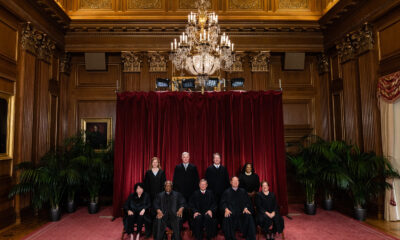
 Politics6 months ago
Politics6 months agoHow Republicans could foil Harris’ Supreme Court plans if she’s elected
-
Uncategorized6 months ago
Johnson plans to bring House GOP short-term spending measure to House floor Wednesday
-
Economy6 months ago
It’s still the economy: What TV ads tell us about each campaign’s closing message
-
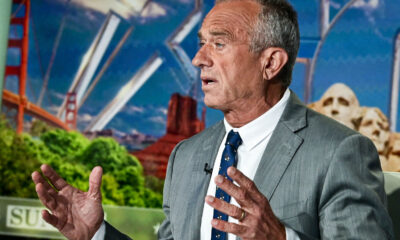
 Politics6 months ago
Politics6 months agoRFK Jr.’s bid to take himself off swing state ballots may scramble mail-in voting


